2015 Peugeot 308 eco mode
[x] Cancel search: eco modePage 387 of 416
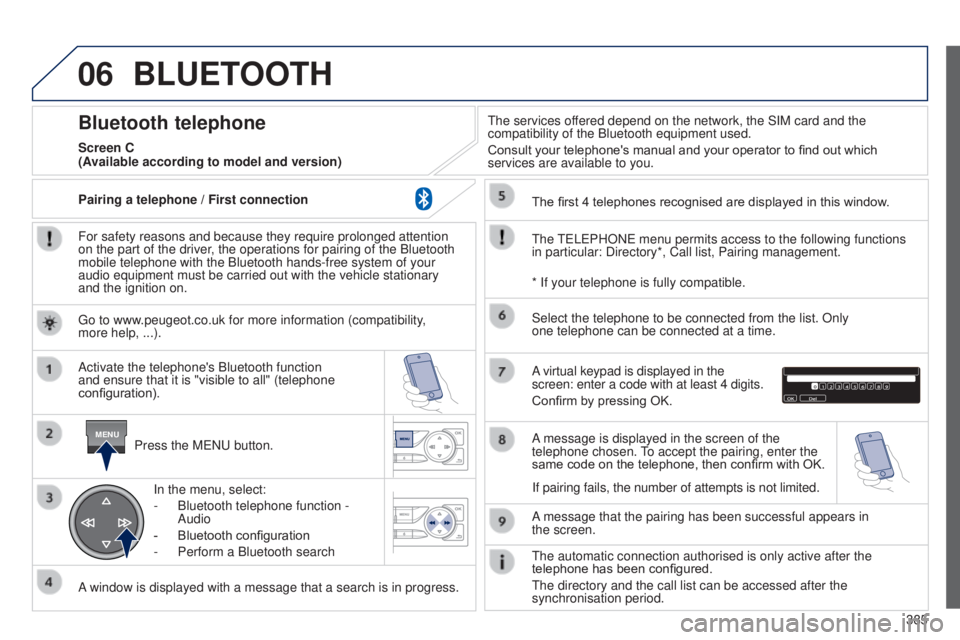
06
MENU
385
BLUETOOTH
For safety reasons and because they require prolonged attention
on the part of the driver, the operations for pairing of the Bluetooth
mobile telephone with the Bluetooth hands-free system of your
audio equipment must be carried out with the vehicle stationary
and the ignition on.Press the M
e N u button.
A window is displayed with a message that a search is in progress. Activate the telephone's Bluetooth function
and ensure that it is "visible to all" (telephone
configuration). In the menu, select:
-
Bluetooth telephone function
-
Audio
-
Bluetooth configuration
-
Perform a Bluetooth search
t
he services offered depend on the network, the SIM card and the
compatibility of the Bluetooth equipment used.
Consult your telephone's manual and your operator to find out which
services are available to you.
Bluetooth telephone
Screen C
t
he
te
L e PHON e menu permits access to the following functions
in particular: Directory*, Call list, Pairing management. The first 4 telephones recognised are displayed in this window.
A virtual keypad is displayed in the
screen: enter a code with at least 4 digits.
Confirm by pressing OK.
A message that the pairing has been successful appears in
the
screen.
Select the telephone to be connected from the list. Only
one
telephone can be connected at a time.
A message is displayed in the screen of the
telephone chosen.
to accept the pairing, enter the
same code on the telephone, then confirm with OK.
t
he automatic connection authorised is only active after the
telephone has been configured.
t
he directory and the call list can be accessed after the
synchronisation period.
(Available according to model and version)
* If your telephone is fully compatible.
If pairing fails, the number of attempts is not limited.
g
o to www.peugeot.co.uk for more information (compatibility,
more
help, ...).
Pairing a telephone
/ First connection
Page 393 of 416
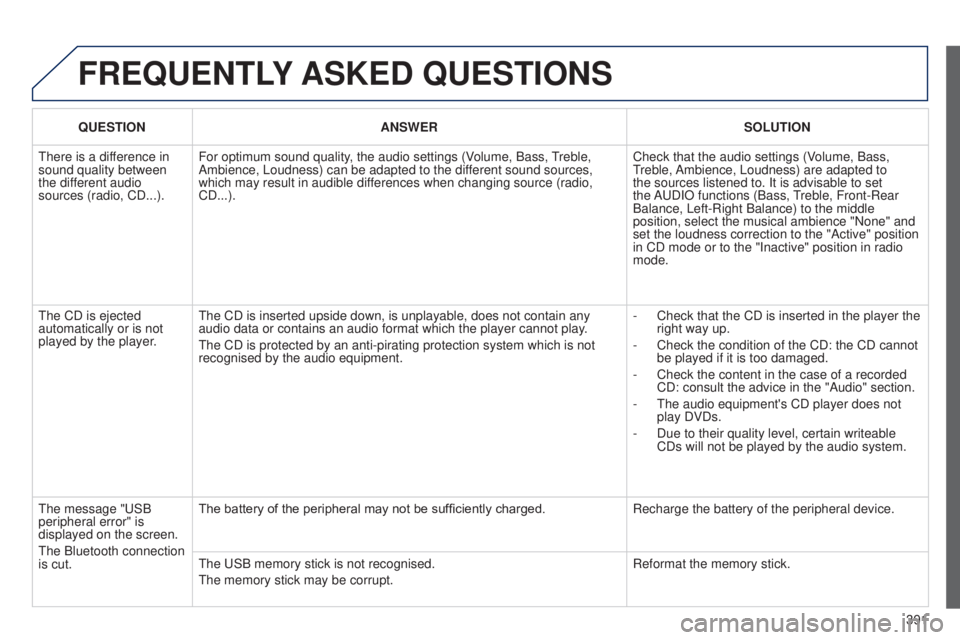
391
FREqUENTLY ASKED q UESTIONS
qUESTION ANSWER SOLUTION
t
here is a difference in
sound quality between
the different audio
sources (radio, CD...). For optimum sound quality, the audio settings (Volume, Bass,
treble,
Ambience, Loudness) can be adapted to the dif
ferent sound sources,
which may result in audible differences when changing source (radio,
CD...). Check that the audio settings (Volume, Bass,
treble,
Ambience, Loudness) are adapted to
the sources listened to. It is advisable to set
the A
u DIO functions (Bass,
treble, Front-Rear
Balance, Left-Right Balance) to the middle
position, select the musical ambience "None" and
set the loudness correction to the "Active" position
in CD mode or to the "Inactive" position in radio
mode.
t
he CD is ejected
automatically or is not
played by the player.
t
he CD is inserted upside down, is unplayable, does not contain any
audio data or contains an audio format which the player cannot play.
t
he CD is protected by an anti-pirating protection system which is not
recognised by the audio equipment. -
Check that the CD is inserted in the player the
right way up.
-
Check the condition of the CD: the CD cannot
be played if it is too damaged.
-
Check the content in the case of a recorded
CD: consult the advice in the "Audio" section.
-
t he audio equipment's CD player does not
play DVDs.
-
Due to their quality level, certain writeable
CDs will not be played by the audio system.
t
he message " u SB
peripheral error" is
displayed on the screen.
t
he Bluetooth connection
is cut. The battery of the peripheral may not be sufficiently charged.
Recharge the battery of the peripheral device.
t
he u SB memory stick is not recognised.
t
he memory stick may be corrupt. Reformat the memory stick.
Page 395 of 416
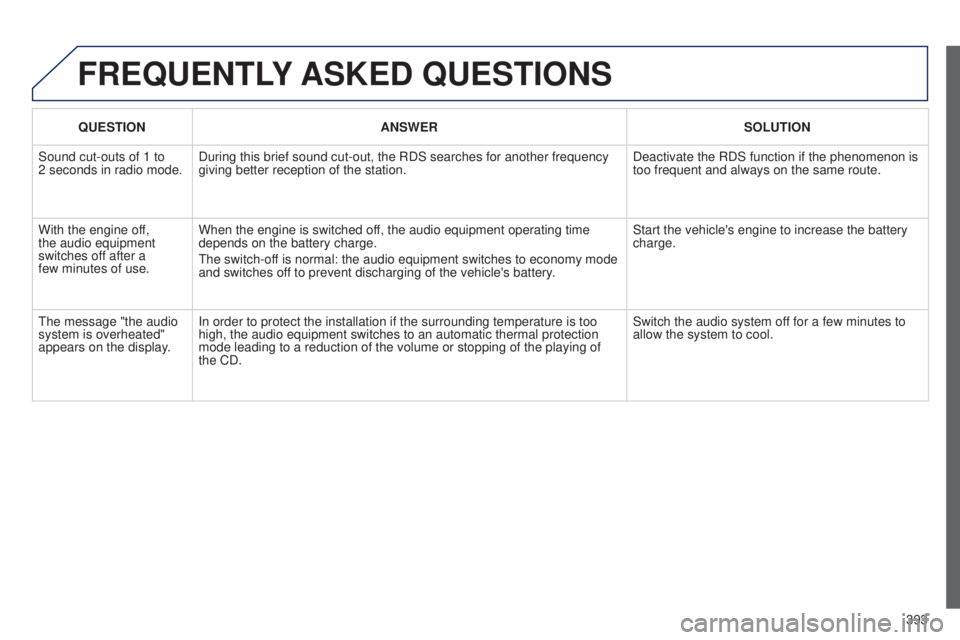
393
FREqUENTLY ASKED q UESTIONS
qUESTION ANSWER SOLUTION
Sound cut-outs of 1 to
2
seconds in radio mode. During this brief sound cut-out, the RDS searches for another frequency \
giving better reception of the station. Deactivate the RDS function if the phenomenon is
too frequent and always on the same route.
With the engine off,
the audio equipment
switches off after a
few
minutes of use. When the engine is switched off, the audio equipment operating time
depends on the battery charge.
t
he switch-off is normal: the audio equipment switches to economy mode
and switches off to prevent discharging of the vehicle's battery. Start the vehicle's engine to increase the battery
charge.
t
he message "the audio
system is overheated"
appears on the display. In order to protect the installation if the surrounding temperature is t\
oo
high, the audio equipment switches to an automatic thermal protection
mode leading to a reduction of the volume or stopping of the playing of \
the CD. Switch the audio system off for a few minutes to
allow the system to cool.
Page 398 of 416
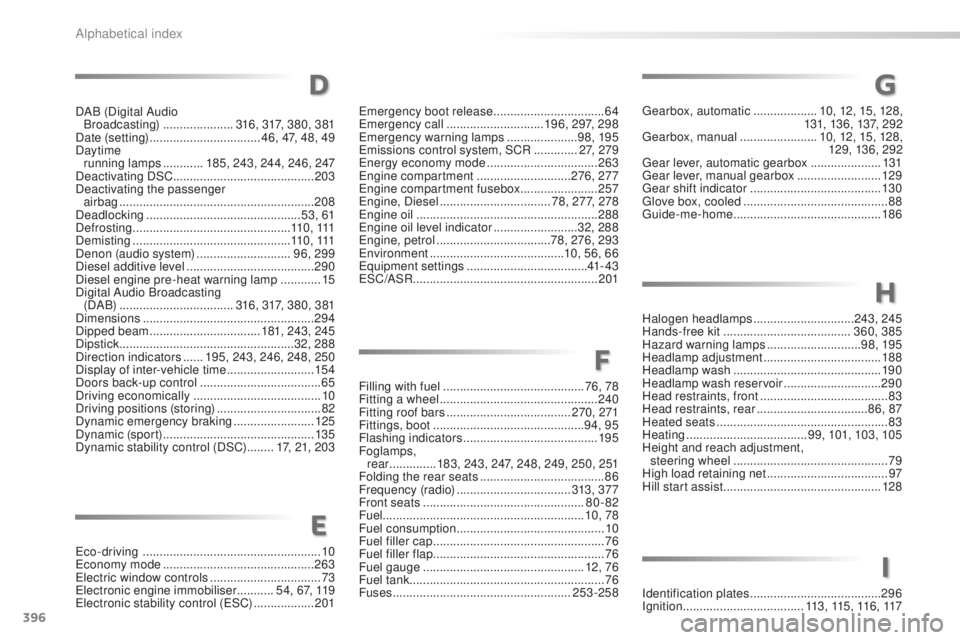
396
Filling with fuel ..........................................76 , 78
Fitting a wheel ............................... ................240
Fitting roof bars
..................................... 270, 271
Fittings, boot
............................................. 9
4, 95
Flashing indicators
........................................ 195
Foglamps, rear
.............. 1
83, 243, 247, 248, 249, 250, 251
Folding the rear seats
..................................... 86
Frequency (radio)
.................................. 313, 37 7
Front seats
................................................ 80-82
Fuel ............................................................ 10, 78
Fuel consumption
............................................ 10
F
uel filler cap ................................................... 76
Fuel filler flap
................................................... 76
Fuel gauge
................................................ 12, 76
Fuel tank .......................................................... 76
Fuses
..................................................... 253-258
F
G
eco-driving ..................................................... 10ec
onomy mode ............................................. 263
ele
ctric window controls
.................................73
el
ectronic engine immobiliser ........... 54, 67, 119
el
ectronic stability control (
e
SC) ..................201
DAB (Digital Audio
Broadcasting)
.....................
316, 317, 380, 381
Date (setting)
...............................
..
46, 47, 48, 49
Daytime running lamps
............
185, 243, 244, 246, 247
Deactivating DSC .......................................... 203
Deactivating the passenger airbag
.......................................................... 20
8
Deadlocking
..............................................
53, 61
Defrosting
...............................................
11 0 , 111
Demisting
...............................
................
11 0 , 111
Denon (audio system) ............................
96, 299
Diesel additive level
......................................
290
Diesel engine pre-heat warning lamp
............
15
Digital Audio Broadcasting (DA B)
..................................
316, 317, 380, 381
Dimensions
...................................................
294
Dipped beam
...............................
..
181, 243, 245
Dipstick
................
....................................
32, 288
Direction indicators
......
195, 243, 246, 248, 250
Display of inter-vehicle time
..........................
15 4
Doors back-up control ....................................
65
Driving economically ...................................... 10
Driving positions (storing)
...............................
82
Dynamic emergency braking
........................ 12
5
Dynamic (sport)
...............................
..............
13 5
Dynamic stability control (DSC)
........ 1
7, 21, 203
E
gearbox, automatic
...................10, 12, 15, 128,
131, 13 6, 137, 2 92
ge
arbox, manual
.......................10, 12, 15, 128,
129, 136, 292
gea
r lever, automatic gearbox
..................... 13
1
ge
ar lever, manual gearbox
.........................129
ge
ar shift indicator
....................................... 13 0
gl
ove box, cooled ........................................... 88
gu
ide-me-home
............................................ 18 6em
ergency boot release ................................. 64em
ergency call ............................. 1
96, 297, 298
em
ergency warning lamps
..................... 9
8, 195
em
issions control system, SCR
............. 27, 279
en
ergy economy mode
................................. 263
en
gine compartment
............................ 276, 277
en
gine compartment fusebox
....................... 257
en
gine, Diesel
................................. 7
8, 277, 278
en
gine oil
...................................................... 288
en
gine oil level indicator
......................... 32, 288
en
gine, petrol
.................................. 78, 276, 293
en
vironment
...............................
......... 10, 56, 66
eq
uipment settings
.................................... 41- 4 3
eS
C/ASR
...............................
........................ 201
D
H
Halogen headlamps ..............................243, 245
Hands-free kit ...................................... 360, 385
Hazard warning lamps
............................98, 195
Headlamp adjustment
...................................188
Headlamp wash
............................................ 19 0
Headlamp wash reservoir
.............................290
Head restraints, front
...................................... 83
Head restraints, rear
.................................86, 87
Heated seats
................................................... 83
Heating
.................................... 99, 101, 103, 105
Height and reach adjustment, steering wheel
.............................................. 79
High load retaining net
....................................97
Hill start assist
............................................... 12
8
I
Identification plates .......................................29 6
Ignition ................ ....................113 , 115 , 11 6 , 117
Alphabetical index
Page 413 of 416
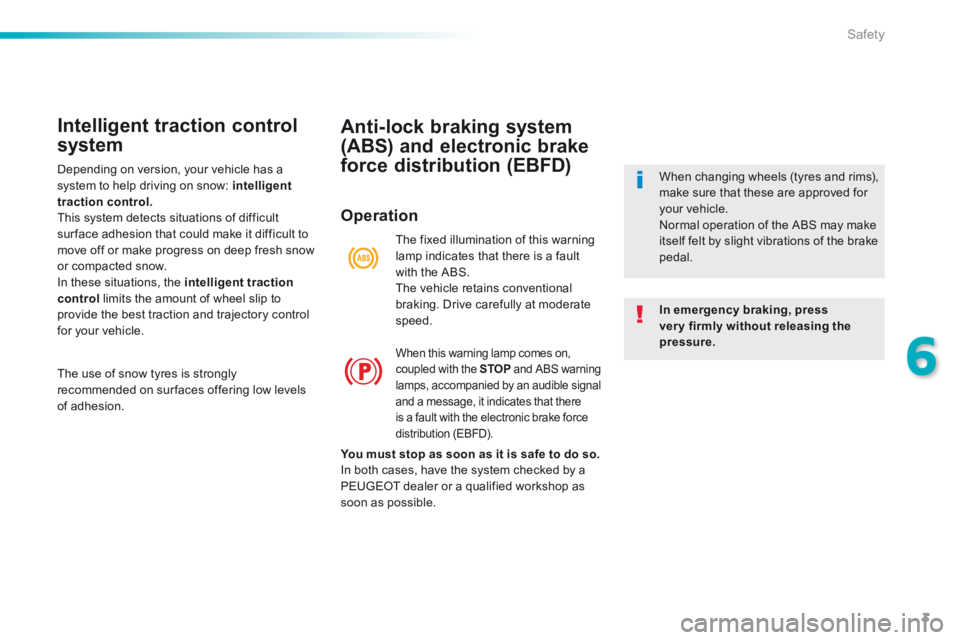
3
6
Safety
308GTi_en_Chap06_securite_ed01-2015
Anti-lock braking system
(ABS) and electronic brake
force distribution (EBFD)
Operation
In emergency braking, press very firmly without releasing the pressure.
When changing wheels (tyres and rims), make sure that these are approved for your vehicle.
Normal operation of the ABS may make itself felt by slight vibrations of the brake pedal.
The fixed illumination of this warning lamp indicates that there is a fault with the ABS. The vehicle retains conventional braking. Drive carefully at moderate speed.
When this warning lamp comes on, coupled with the STOP and ABS warning lamps, accompanied by an audible signal and a message, it indicates that there is a fault with the electronic brake force
distribution (EBFD).
Intelligent traction control
system
The use of snow tyres is strongly recommended on sur faces offering low levels of adhesion.
You must stop as soon as it is safe to do so. In both cases, have the system checked by a PEUGEOT dealer or a qualified workshop as soon as possible.
Depending on version, your vehicle has a system to help driving on snow: intelligent traction control. This system detects situations of difficult sur face adhesion that could make it difficult to move off or make progress on deep fresh snow or compacted snow. In these situations, the intelligent traction control limits the amount of wheel slip to provide the best traction and trajectory control for your vehicle.
Page 415 of 416

7
9
Technical data
308GTi_en_Chap09_caracteristiques-techniques_ed01-2015
308 GTi engines and
gearboxes
Engine1.6 litre THP 250 hp S&S1.6 litre THP 270 hp S&S
Gearbox Manual (6-speed)
Model code L3 5GP L3 5GN
Cubic capacity (cc) 1 598
Bore x stroke (mm) 77 x 85.8
Max power: EU standard (kW) * 18 4 200
Max power engine speed (rpm) 6 000
Max torque: EU standard (Nm) 330
Max torque engine speed (rpm) 1 900
Fuel Unleaded petrol
Catalytic converter yes
Oil capacities (in litres)
Engine (with replacement of the filter element) 4.25
* The maximum power corresponds to the type approved value on a test bed, under conditions defined by European legislation
(directive 1999/99/EC).
308 GTi weights and towed
loads (in kg)
Engine1.6 litre THP 250 hp S&S1.6 litre THP 270 hp S&S
Gearbox Manual (6-speed)
Model code L3 5GP L3 5GN
- Unladen weight 1 205
- Kerb weight 1 280
- Gross vehicle weight (GV W) 1 790
- Gross train weight (GTW) on a 12 % gradient 1 790
- Braked trailer (within GTW limit) on a 10 % or 12 % gradient -
- Braked trailer (with load transfer within the GTW limit) -
- Unbraked trailer -
- Recommended nose weight -
Your vehicle cannot be fitted with a towbar.